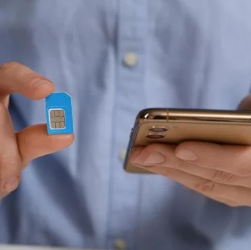Introduction to SIM Cards for International Travel
Traveling abroad is an exciting adventure, but staying connected can be a challenge. With the rise of global connectivity, having access to reliable and affordable mobile data and voice services has become a necessity for many travelers. One solution to this problem is using a travel SIM card, which can help you avoid exorbitant roaming charges and stay connected while exploring new destinations. In this blog post, we’ll explore the pros and cons of using international and local SIM cards for travelers, helping you make an informed decision about the best option for your next trip.

What is a Travel SIM Card?
A travel SIM card, also known as an international SIM card or roaming SIM card, is a prepaid SIM card that allows you to access mobile data, make calls, and send text messages while traveling abroad. These SIM cards will work with local networks in the countries you visit, giving you a local phone number and competitive rates for data, calls, and texts.
There are two main types of travel SIM cards:
- Local SIM cards: Specific to a single country or region.
- International SIM cards: Offer coverage across multiple countries and regions.
Why You Need a Travel SIM Card
Using your regular SIM card while traveling abroad can result in expensive roaming charges from your home mobile service provider. These charges can quickly add up, especially if you plan to use data-intensive applications or make frequent calls. A travel SIM card provides a cost-effective alternative by allowing you to access local networks at your destination, often at significantly lower rates than international roaming plans.
Additionally, having a local or international SIM card can be incredibly convenient for various travel-related activities, such as:
- Navigating with maps and GPS
- Staying connected with friends and family through messaging apps
- Accessing travel information and booking services
- Sharing your travel experiences on social media
- Conducting business or work-related tasks while on the go
By avoiding the hassle of roaming charges and ensuring reliable connectivity, a travel SIM card can enhance your overall travel experience and provide peace of mind.
Local SIM Cards: Pros and Cons
Advantages of Local SIM Cards
- Cost-effective for single destinations: If you’re traveling to a single country or region, a local SIM card can be a cost-effective solution. These cards are often inexpensive and offer competitive rates for data, calls, and texts within the local network.
- Familiarity with local providers: When you purchase a local SIM card, you’re dealing with a familiar and established local mobile network provider. This can make the process of purchasing, activating, and using the SIM card more straightforward.
- Potential for better coverage: Local SIM cards may offer better coverage and network performance within the country or region they are designed for, as the provider has optimized their network for that specific area.
Disadvantages of Local SIM Cards
- Limited coverage: Local SIM cards are restricted to a single country or region, which can be inconvenient if you plan to visit multiple destinations during your trip. You may need to purchase a new SIM card for each country you visit, adding to the overall cost and hassle.
- Language barriers: Purchasing and setting up a local SIM card can be challenging if you don’t speak the local language or are unfamiliar with the local customs and procedures.
- Potential for hidden fees: Some local SIM card providers may have hidden fees or restrictions, such as limited data allowances or expiration dates, which can lead to unexpected charges or service interruptions.
International SIM Cards: Pros and Cons
Benefits of International SIM Cards
- Wide coverage: International SIM cards are designed to work across multiple countries and regions, providing you with a seamless connectivity experience throughout your travels. This can be particularly useful if you plan to visit multiple destinations during your trip.
- Convenience: With an international SIM card, you don’t need to worry about purchasing a new SIM card for each country you visit. This can save you time and hassle, allowing you to focus on enjoying your trip.
- Consistent rates: International SIM card providers often offer consistent rates for data, calls, and texts across the countries and regions they cover. This can help you better manage your communication expenses and avoid unexpected charges.
- Centralized support: Many international SIM card providers offer centralized customer support, which can be helpful if you encounter any issues or have questions while traveling.
Drawbacks of International SIM Cards
- Higher upfront cost: International SIM cards typically have a higher upfront cost compared to local SIM cards, as they need to cover the cost of maintaining agreements with multiple network providers across different countries.
- Potential for network quality issues: While international SIM cards offer wide coverage, the network quality and performance may vary depending on the country and the agreements the provider has with local networks.
- Limited customization options: International SIM card providers may offer fewer customization options or data package choices compared to local providers, as they need to cater to a broader audience.
How to Choose the Right SIM Card for Your Trip
When deciding between a local or international SIM card, consider the following factors:
- Travel destinations: If you’re visiting a single country or region, a local SIM card may be the most cost-effective option. However, if you plan to visit multiple destinations, an international SIM card could provide more convenience and consistent coverage.
- Duration of your trip: For shorter trips, a local SIM card may suffice, while an international SIM card could be more suitable for longer or extended travel periods.
- Data and voice usage needs: Evaluate your anticipated data and voice usage during your trip. If you plan to use data-intensive applications or make frequent calls, an international SIM card with larger data packages and competitive voice rates may be a better choice.
- Budget: Consider the upfront and ongoing costs associated with each option. While international SIM cards may have a higher initial cost, they could potentially save you money in the long run if you’re visiting multiple countries.
- Convenience and support: If you value the convenience of having a single SIM card for your entire trip and access to centralized support, an international SIM card may be the better option.
Purchasing and Setting Up Your Travel SIM Card
Once you’ve decided on the type of travel SIM card that best suits your needs, it’s time to purchase and set it up. Here are some general steps to follow:
- Research providers: Explore different local and international SIM card providers to find the best option for your travel plans. Consider factors such as coverage, data packages, voice rates, and customer reviews.
- Purchase your SIM card: You can typically purchase local SIM cards at airports, convenience stores, or mobile service provider shops upon arrival at your destination. International SIM cards, on the other hand, are usually purchased online and shipped to you before your trip.
- Ensure device compatibility: Make sure your mobile device is unlocked and compatible with the SIM card you’ve chosen. Some providers may offer compatibility checks or guides to help you determine if your device is suitable.
- Activate and set up: Follow the instructions provided by your SIM card provider to activate and set up your new SIM card. This may involve registering your card, adding credit or purchasing a data package, and configuring your device’s settings.
- Test your connection: Once your SIM card is activated, test your mobile data and voice connectivity to ensure everything is working correctly before embarking on your trip.
Tips for Using Your SIM Card Abroad
To make the most of your travel SIM card and ensure a seamless connectivity experience, consider the following tips:
- Monitor your data usage: Keep an eye on your data usage, especially if you’re on a limited data package. Many SIM card providers offer apps or online portals to help you track your usage and top up your data as needed.
- Enable data roaming: Make sure to enable data roaming on your device when traveling to different countries or regions, especially if you’re using an international SIM card.
- Utilize Wi-Fi when available: While a travel SIM card can provide reliable mobile data, it’s always a good idea to take advantage of free or secure Wi-Fi networks when available to conserve your data allowance.
- Keep your SIM card safe: Treat your travel SIM card like any other valuable item and keep it safe from loss or damage. Consider carrying a backup SIM card or having a backup plan in case of emergencies.
- Familiarize yourself with local emergency numbers: Note down the local emergency numbers for the countries or regions you’ll be visiting, as these may differ from your home country’s emergency numbers.
Exploring Alternative Options: eSIM for Travelers
In addition to traditional physical SIM cards, travelers now have the option of using an eSIM (embedded SIM) for their connectivity needs. An eSIM is a digital SIM card that is built into your device’s hardware, eliminating the need for a physical SIM card.
Using an eSIM for roaming offers several advantages compared to traditional SIM cards, including:
- Convenience: You can purchase and activate an eSIM plan directly from your device, without the need to physically swap SIM cards.
- Flexibility: With an eSIM, you can easily switch between different mobile plans and providers, allowing you to take advantage of the best deals and coverage in different regions.
- Security: eSIMs are more secure than physical SIM cards, as they are integrated into your device’s hardware and cannot be easily removed or tampered with.
Conclusion
Choosing the right travel SIM card can make a significant difference in your overall travel experience. Whether you opt for a local SIM card for a single destination or an international SIM card for multi-country trips, understanding the pros and cons of each option will help you make an informed decision.
Remember to consider factors such as your travel destinations, duration, data and voice usage needs, budget, and desired convenience and support. Additionally, keep an eye out for emerging technologies like eSIM, which offer even more flexibility and convenience for staying connected while on the go.
By taking the time to research and select the best travel SIM card for your needs, you can stay connected, avoid exorbitant roaming charges, and fully immerse yourself in the adventure of international travel.





